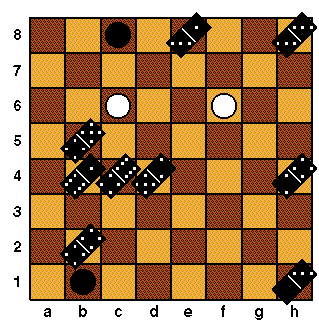
White draws 6-5 and loses. White cannot move f6 vertically to make room for c6 to move, because the domino is immediately placed at f6.
We chose the name in part because the goal is to hem in your opponent, but mostly because the most distinctive component is a set of dominoes.
The dominoes should be small enough that they can be laid flat on a square of the board without overlapping too much into other squares. Laying them at a 45-degree angle helps.
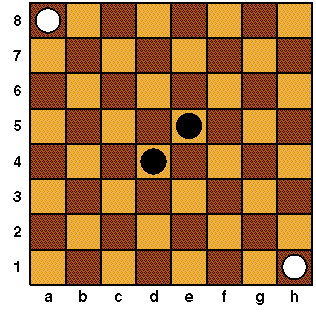 Set up the board as shown on the right.
(Chess style rank and file notations are included for later reference.)
Set up the board as shown on the right.
(Chess style rank and file notations are included for later reference.)
The board is considered to "wrap around" at the edges. That is, a piece that moves off one edge re-enters immediately at the opposite edge. (For instance, if the piece at h1 moves to the right it moves to a1.) Thus the starting position is symmetric between White and Black.
Mix the dominoes face down. (Be careful that the double-blank is face down!) Decide who will go first. Play alternates. A turn consists of drawing a domino from the remaining face down pool, moving one's pieces based on the numbers on the domino, and placing the domino on the board in place of the first piece moved. Details follow:
Each turn, a player must move both of his or her pieces. One piece moves a distance equal to one of the numbers on the domino, the other moves a distance equal to the other number. Either number may be used first. A blank may be used to move any distance from 1 to 6 (not zero). A piece is moved in a straight line horizontally or vertically. A piece may never move onto or through another piece of either color, nor onto or through a domino. The new domino is placed on the board after the first piece is moved on a turn, occupying the space from which that piece moved.
If a player is unable to move both pieces, that player loses.
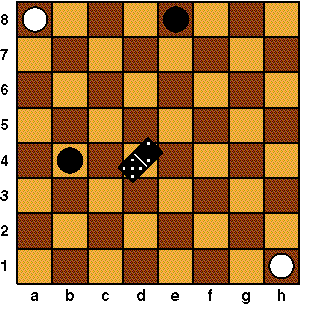 Suppose Black goes first and draws 5-2. One possible move is
d4-b4 (placing the domino at d4), then e5-e8 (moving down and
wrapping around at the edge), giving the position shown on the left.
(This is perhaps not a very good move, but it's useful as an example.)
Suppose Black goes first and draws 5-2. One possible move is
d4-b4 (placing the domino at d4), then e5-e8 (moving down and
wrapping around at the edge), giving the position shown on the left.
(This is perhaps not a very good move, but it's useful as an example.)
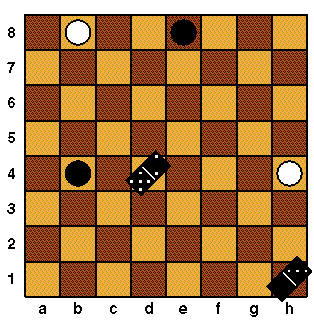
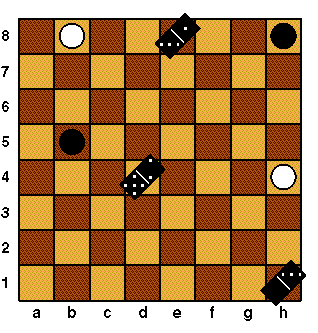
Now White at h4 can move no further than 3, and at b8 no further than 4, so there are 13 dominos in the pool that would lose for White.
The above shows a game where both players are attempting to restrict each other's moves, but you can see that by doing so they also restrict their own. They might instead move so as to make it difficult for the opponent to interfere with their open lines. This decision between offense and defense is at the heart of the game.
One final point of emphasis: Remember that the domino is placed immediately
after the first move of each turn. This means it is never
possible to move one piece out of the way in order to let your other piece
move past. In the position below,

White draws 6-5 and loses. White cannot move f6 vertically to make room
for c6 to move, because the domino is immediately placed at f6.
The main effect of this variant is that one can have a piece trapped and yet continue playing with the other pieces. One's moves will be more limited, but it may still be possible to engineer a victory. And in some cases the trapped piece will eventually work its way into play again.
Another variation is to say that if a player draws a domino and cannot play it, the game is not over. The player does not move either piece, and keeps the domino, leaving it face up so both players can remember it is out of play. The players continue to alternate turns as before; each time an unplayable domino is drawn, it is kept face-up in front of the drawing player. After all the dominos have been drawn, whichever player drew fewer unplayable dominos wins. If there's a tie, the second player wins. (This makes up for the fact that, on the first player's last turn, it is possible to determine exactly which domino remains for the second player to draw.)
Like the first variant, one effect of this latter variation is that you must be careful not to get into too bad a position in the course of trapping the other player. That is, you can't necessarily afford to wedge yourself into a dead end even if you manage to get the other player to draw a bad domino.